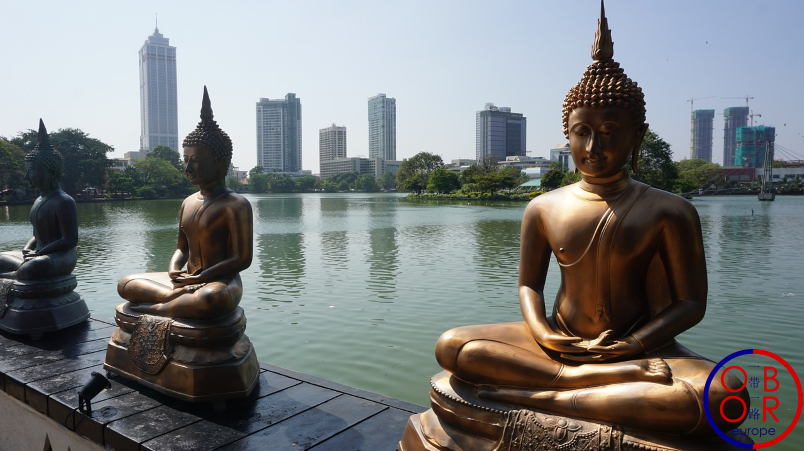by Ms. Natasha Fernando

China’s One Belt One Road Initiative is more than a global network of infrastructure projects, but a strategic move of Chinese statecraft to connect the Asia-Pacific Region for mutual investment opportunities, expand export markets, and develop economic links through enhanced connectivity. The OBOR is being resented by the United States of America and some of its proxies as challenging a set of values and beliefs. The United States of America in its Indo-Pacific Strategic Report 2019 listed China as a ‘revisionist power’. With the global outbreak of COVID-19, anti-Chinese sentiments have expanded globally. This negativity is inimical to realizing the OBOR and its benefits for the countries. South Asia in particular is a region with many OBOR-related projects but undergoing several challenges and roadblocks due to nationalism, anti-Chinese and anti-globalization sentiments.
The reluctance of India to join the OBOR with the perception that China challenges India’s regional influence is one of the main reasons that prevents South Asia’s comprehensive integration with the OBOR. This article series will tackle how to make OBOR work in South Asia emerging from the COVID-19 crisis.
OBOR and Sri Lanka: a continued partnership
China-Sri Lanka relations date back to the 4th century AD with the visit of Chinese monk Faxian.
During the 20th century, Sri Lanka-Chinese relations were solidified by the Rubber Rice pact in 1952, enabling the Chinese to purchase rubber at a time when they were unable to do so due to sanctions.This pact was operational for 30 years and according to Kelegama it was “one of the most successful and durable South-South trade agreements in the world”. Sri Lanka has continuously supported China at the international level on two notable occasions: China’s admission to the UN Security Council in 1971, and support for China to enter the World Trade Organization in 2001.
Diplomatic relations with China was established in 1957. The Economic and Technological Cooperation Agreement in 1962 followed by the maritime agreement granted Most Favored Nation status to commercial vessels of cargo and passengers services between the two countries or a third country. In 1972, with Prime Minister Sirimao Bandaranaike visiting China, aid was granted to construct the Bandaranaike Memorial International Conference Hall (BMICH).
In 1982, the Sino-Lanka Joint Trade Committee was established. Two years later, Sino-Lanka Economic and Trade Cooperation committee was created. Both were amalgamated in 1991 as the Sino-Lanka Joint Commission for Economic and Trade Cooperation. In 1994 during the presidency of Chandrika Bandaranaike Kumaratunga, following in her mother’s footsteps’ the Sri Lanka-China Business Cooperation Council was formed. It must be noted that Chinese-Sri Lankan relations were never hostile but China has supported Sri Lanka throughout history.
When the Rubber-Rice pact was signed in 1952, several Western countries revoked aid for Sri Lanka despite which relations continued. It was the same case during Sri Lanka’s armed conflict with the terrorist organization of Liberation Tigers of Tamil Ealam. When many countries were reluctant citing human rights concerns, China supplied weapons, diplomatic support and aid to fight terrorism. In 2005, with the presidency of Mahinda Rajapaksa, bilateral relations further strengthened. Eight Memorandum of Understandings and Agreements were signed spanning various areas of cooperation such as business and technical assistance, urban development, sacred area development, investment promotion, film, television and radio industry, health, agriculture and establishment of a Confucius center. By 2010, China had become the largest foreign finance partner of Sri Lanka.
Infrastructure projects
Most remarkable were the large scale infrastructure development projects which include: the Hambantota Port, the Mattala International Airport, the Colombo-Katunayake Expressway, the Narocholai Coal Power Plaint, the Moragahakanda Multipurpose Development Project, the Matara-Kataragama Railway Line, and the Colombo International Financial City (CIFC). Out of these projects the CIFC and Hambantota port are flagship projects of the Belt and Road Initiative. The New York Times published an article in 2018 which criticized the Hambantota port as a white elephant project trapping Sri Lanka in heavy debt with pessimistic tones the Port would not work. In fact, the negative narrative of the debt-equity swap, Sri Lanka conceding the port to Chinese control for cancelling debt, should be debunked. In 2017 a 70 percent stake of the port was leased to China Merchants Port Holdings Company Limited for 99 years for $1.12 billion. This was done to strengthen foreign reserves and cover balance of payment issues. The development of the Hambantota Industrial zone is key to incentivize connectivity offering Sri Lanka an opportunity to join regional and transnational ports network. Companies could now invest in oil refineries, storage facilities, and Liquefied Natural Gas (LNG) bunkering.
The Colombo International Financial City is the largest investment project in Sri Lanka which will be completed in 2040. This is a US$ 15 billion investment; a metropolis inside Colombo with a residential area, businesses, and recreation facilities. All the Chinese-funded infrastructure projects were initiated during the regime of President Mahinda Rajapaksa, who was heavily criticized by opposition parties in Sri Lanka for a pro-china leaning foreign policy. Even during the Sirisena-Yahapalanaya government in 2015, the Chinese development projects were continued but met with hostility by NGOs and pressure groups on various grounds such as environmental issues, sovereignty issues and corruption etc. Although there was no Environmental Impact Assessment done initially for the CIFC, Chinese authorities have now responded to the criticisms and have committed to a long-term Sustainability Master Plan. The election of President Gotabhaya Rajapaksa who was formerly providing administrative direction to the Ministry of Urban Planning will strengthen ties with China to realize these projects and attract investors to compete with international financial cities like Hong Kong, Dubai and Singapore.
The views expressed in this article are those of the author, and do not necessarily reflect the views of OBOReurope.
